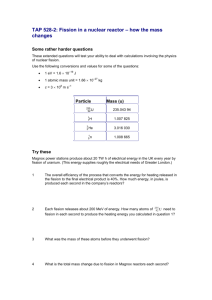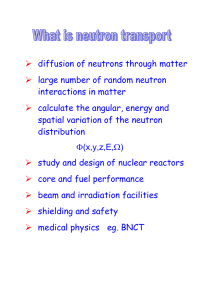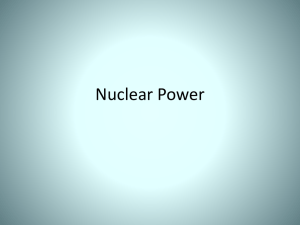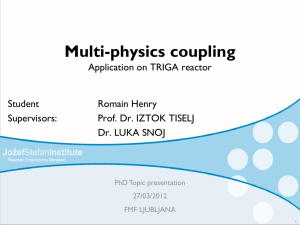The Nuclear Energy Alternative
advertisement
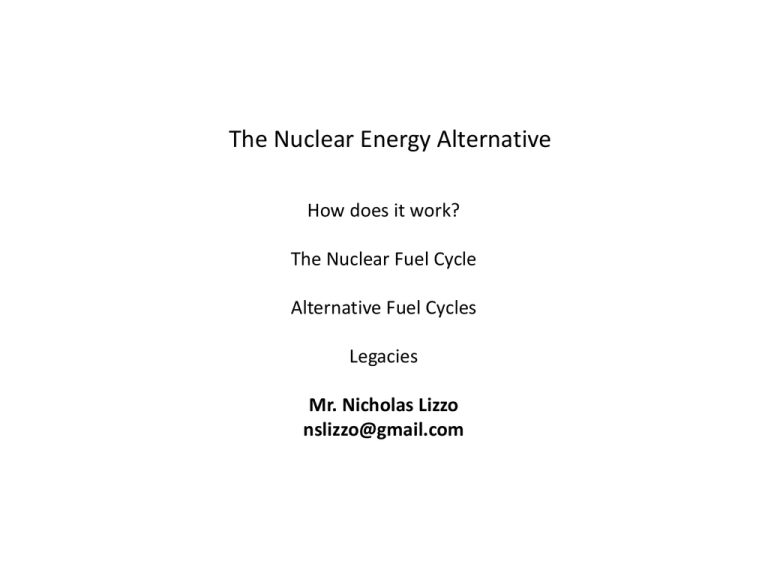
The Nuclear Energy Alternative How does it work? The Nuclear Fuel Cycle Alternative Fuel Cycles Legacies Mr. Nicholas Lizzo nslizzo@gmail.com Nuclear Power Generation Reactor (primary loop) Steam Generator (Secondary Loop) Condenser (Tertiary Loop) Reactor Coolant System – 4 Loop PWR Reactor Vessel Height - 43’ Width – 15’ Weight - 435 Tons Active fuel region: 193 assemblies 3.5% enriched U-235 Fission Process Thermal Neutron “Uranium-235” Fission Fission Products Fast Neutrons + Energy Key Components of the Reactor Design • • • • • • Neutron Energy Fission atom (fuel) Probability of Fission f(E)n, fuel Moderator Coolant Products of Reactions Neutron Energy ( 1 eV = 1.602 x 10-19 joules) Neutron Energy Distribution from Fission FISSILE AND FISSIONABLE NUCLIDES PRESENT IN LIGHT WATER REACTORS Nuclide 235 92 U 238 92 U Thermal Neutron Microscopic Cross Section for Fission (barns) 585 5 10-6 239 94 Pu 750 240 94 Pu 0.05 241 94 1010 242 94 < 0.2 Pu Pu One barn = 1 x 10 – 24 cm2 Fissile or Fissionable Fissile Fissionable Fissile Fissionable Fissile Fissionable How do we characterize: Probability of fission? Cross section (target area for incident particle) Thermal region How do we slow down (thermalize) the fission spectrum neutrons? 2 MeV NEUTRON 0.025 eV NEUTRON Ei Ef COLLISION Ei ln Ef BIRTH AT HIGH ENERGY 2 MeV ENERGY LOSSES UPON COLLISION NEUTRON ENERGY AVERAGE THERMAL ENERGY TIME = logarithmic energy decrement Ei = initial energy level of neutron Ef = final energy level of neutron COMPARISON OF MODERATORS MATERIAL COLLISIONS TO THERMALIZE MICROSCOPIC CROSS SECTION (BARNS) sa MODERATING RATIO ss H2 O 0.948 19 0.66 103 148 D2 O 0.570 35 0.001 13.6 7752 Be 0.209 86 0.0092 7.0 159 C 0.158 114 0.003 4.8 253 FISSION ENERGY INSTANTANEOUS KINETIC ENERGY OF FISSION FRAGMENTS KINETIC ENERGY OF FISSION NEUTRONS INSTANTANEOUS GAMMA RAYS 165 MeV 5 MeV 7 MeV DELAYED KINETIC ENERGY OF BETA PARTICLES DECAY GAMMA RAYS NEUTRINOS TOTAL ENERGY RELEASED 7 MeV 6 MeV 10 MeV 200 MeV TRACK LENGTH DESCRIPTION OF NEUTRON FLUX 1 CUBIC CENTIMETER NEUTRONS cm NEUTRONS sec cm3 cm 2 sec NEUTRON DENSITY NEUTRON VELOCITY (Energy) NEUTRON FLUX NEUTRON FLUX Neutrons cm2 sec n n n 1 SQUARE CENTIMETER n n n n Reaction Rate (Fission) R=Nsf Where: R = reaction rate (reactions/cm3 sec) N = atomic density of the fuel (atoms/cm3) s = microscopic cross section (cm2) f = neutron flux (neutrons/cm2 sec) REACTOR POWER P = G N sf V f Where: P = thermal power output (MWt) G = thermal energy produced per fission (3.2 10-17 MWt sec/fission) N = atomic density (fuel atoms/cm3) sf = microscopic fission cross section (cm2) V = fuel volume in the core (cm3) f = neutron flux (neutrons/cm2 sec) k eff e L f p L th f h Control Rods 21 THERMAL NEUTRON LEAKAGE 346 RESONANCE LOSSES p 1038 THERMAL NEUTRON Lth 1017 THERMAL NEUTRONS f 965 THERMAL NEUTRON U-235 FUEL MODERATOR 1400 FAST NEUTRONS BORN 1384 FAST NEUTRONS Lf 58 FAST NEUTRON LEAKAGE 52 THERMAL NEUTRONS ABSORBED BY NON-FUEL ATOMS 1442 FAST NEUTRONS U235 238 239 1400 FAST NEUTRONS h 435 NEUTRONS FROM THERMAL FISSION START CYCLE HERE e Moderator NEUTRONS FROM FAST FISSION 42 Prompt and Delayed Neutrons THE SIX FACTOR REACTOR NEUTRON LIFE CYCLE Nuclear Power Generation Reactor (primary loop) Steam Generator (Secondary Loop) Condenser (Tertiary Loop) The Existing Nuclear Fuel Cycle Spent Fuel Rods Interim Dry Cask Storage Geologic Repository Mining US Mines located in the SW Uranium mines operate in 20 Countries Half of the world’s supply comes from six operating mines Current mining practice results in minimal ecological disturbance Uranium slurry extracted from mines is filtered and then injected with sulfuric acid. Uranium Oxides are a precipitate of the Solution. The precipitate is filtered again and then dried to produce “yellow cake” powder (U3O8) U3O8 is converted to gaseous UF6 Purified U3O8 from the dry process and purified uranium oxide UO3 from the wet process are then reduced in a kiln by hydrogen to UO2: U3O8 + 2H2 ===> 3UO2 + 2H2O deltaH = -109 kJ/mole or UO3 + H2 ===> UO2 + H2O deltaH = -109 kJ/mole This reduced oxide is then reacted in another kiln with gaseous hydrogen fluoride (HF) to form uranium tetrafluoride (UF4), though in some places this is made with aqueous HF by a wet process: UO2 + 4HF ===> UF4 + 2H2O deltaH = -176 kJ/mole The tetrafluoride is then fed into a fluidised bed reactor or flame tower with gaseous fluorine to produce uranium hexafluoride, UF6. Hexafluoride ("hex") is condensed and stored. UF4 + F2 ===> UF6 Removal of impurities takes place at each step. Gaseous UF is used to separate the heavier isotopes of uranium from the lighter in a series of high speed centrifuges. The gas extracted from the center of the centrifuge is enriched in 235U UF – a powder at room temperature, is shipped to a fuel fabrication Facility and converted to UO2 powder Density of UO2 = 10.97 g / cm3 , Length of active fuel = 12 feet SPENT FUEL STORAGE • 55 of 103 US LWRs now using “DRY CASK STORAGE” to store spent fuel. • The Department of Energy was supposed to provide a national storage facility by the mid 1990’s. Yet to materialize • Dry Cask Storage is a method of removing spent fuel from spent fuel pools and storing it in a steel and concrete cask. • Each “Cask” holds 32 Fuel assemblies and is stored on a concrete pad. Repository The Existing Nuclear Fuel Cycle Mill tailings include depleted Uranium Depleted Uranium Spent Fuel Rods Interim Dry Cask Storage Geologic Repository Actinides, including Uranium, Thorium, Plutonium • • • • • • Neutron Energy Fission atom (fuel) Probability of Fission Moderator Coolant Products of Reactions Fast, Epithermal, Thermal Actinides f(E)n, actinide LW, HW, C, Be LW, Liquid Metals, Gases Fission Products (Waste) Actinides (Fuel) Reactor Types Nuclear power plants in commercial operation Reactor type Pressurised Water Reactor (PWR) Boiling Water Reactor (BWR) Pressurised Heavy Water Reactor 'CANDU' (PHWR) Gas-cooled Reactor (AGR & Magnox) Light Water Graphite Reactor (RBMK & EGP) Fast Neutron Reactor (FBR) Main Countries US, France, Japan, Russia, China US, Japan, Sweden Canada UK Russia Russia TOTAL Number GWe Fuel 273 253 enriched UO2 81 76 enriched UO2 48 24 natural UO2 15 8 natural U (metal), enriched UO2 11 + 4 10.2 enriched UO2 2 0.6 PuO2 and UO2 434 372 Coolant water water heavy water CO2 Moderator water water heavy water graphite water liquid sodium graphite none billion kWh Percent Electric Units Output Argentina 5.7 4.4 3 Armenia 2.2 29.2 1 Belgium 40.6 52 7 Brazil 13.8 2.8 2 Bulgaria 13.3 30.7 2 Canada 94.3 16 19 China 104.8 2.1 21 29 35.9 6 Finland 22.7 33.3 4 France 405.9 73.3 58 Germany 92.1 15.4 9 Hungary Czech Republic 14.5 50.7 4 India 30 3.4 21 Iran 3.9 1.5 1 Japan 13.9 1.7 48 Korea RO (South) 132.5 27.6 23 Mexico 11.4 4.6 2 Netherlands 2.7 2.8 1 Pakistan 4.4 4.4 3 Romania 10.7 19.8 2 Russia 161.8 17.5 33 Slovakia 14.6 51.7 4 Slovenia 5 33.6 1 South Africa 13.6 5.7 2 Spain 54.3 19.7 7 Sweden 63.7 42.7 10 25 36.4 5 78.2 43.6 15 United Kingdom 64.1 18.3 16 USA 790.2 19.4 100 WORLD** 2359 c 11 436 Switzerland Ukraine LWR Uranium Recycle without plutonium recovery 30% to 50% improvement in energy extracted LWR Uranium Recycle with plutonium recovery Fuel Cycle Design Imperatives Determine Fuel Cycle Implementation • Minimization of HLW • Proliferation Concern • Radiological Accident Dimension (Design Basis and Beyond) • Energy Output • Carbon Footprint (vs. alternatives in energy mix) Legacies • • • • • • Waste Proliferation & weapons potential Fuel Proven designs / processes / materials Human performance methods (60 to 91%) Lessons Learned App R, Physical Train Separation, Access for Emerg Psnl Training, Staffing, I&C, NUREG 0636, RG 1.97, INPO, Human Factors, Emergency Prep Removal of mid scale failure modes, Auto IB transfer Natural Circ Cooldown Parametersand Training BWR Scram discharge volume & ATWS improvements ATWS procedures, breaker maintenance and design Rod misalignment specs and procedures Focus on failure modes in design / installation of mods Improved criticality monitoring and approach to criticaility procedures MOV PMs, ABFP mods IPTE focus, WANO created FAC inspection s and PM Nuclear Generation Part of the Mix? • • • • • • • • • One hundred US facilities provide 20% US electric power (780 Billion kWh) Power generation 24/7 as base load provides grid stability & reliability One fuel pellet = 17,000 cubic feet of natural gas, one ton of coal Current HLW volume = one football field, 21 feet deep Russian Federation weapons supplied 500 tons of US uranium supply (20,000 weapons) $40 million in wages, 500 jobs per 1000 MW v. 50 jobs for wind or natural gas Carbon emission, including mining, construction, fuel fabrication = 17 tons of CO2 equivalent per GWh (geothermal = 15, wind = 14) Only type of electric generation with required emergency plans and support facilities Current reactor designs could provide 100% (2014 level) of electric supply for 800 years – without mining an additional gram of uranium

